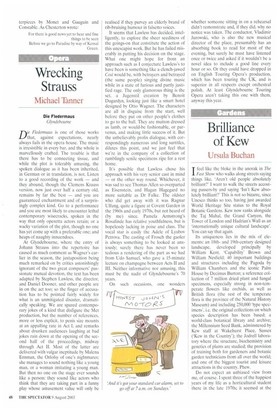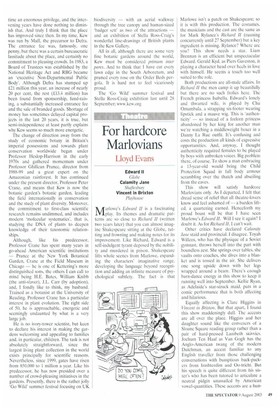Brilliance of Kew
Ursula Buchan
T feel like the bloke in the anorak in The 1 Fast Show who walks along streets saying things like, 'Aren't old people absolutely brilliant?' I want to walk the streets accosting passers-by and saying 'Isn't Kew absolutely brilliant?' This is not so bizarre, since Unesco thinks so too, having just awarded World Heritage Site status to the Royal Botanic Gardens. Kew now ranks alongside the Taj Mahal, the Grand Canyon, the Tower of London and Hadrian's Wall as an 'internationally unique cultural landscape'. You can say that again.
Its uniqueness lies in the mix of elements: an 18thand 19th-century designed landscape, developed principally by William Kent, 'Capability' Brown and William Nesfield; 40 important buildings and structures including the Pagoda by William Chambers and the iconic Palm House by Decimus Burton; a reference collection of 7 million dried plant and fungal specimens, especially strong in non-temperate flowers like orchids, as well as British flora (the rest of the temperate flora is the province of the Natural History Museum) and including 250,000 'type specimens', i.e. the original collections on which species description has been based; a world-class botanical library and archive; the Millennium Seed Bank, adminstered by Kew staff at Wakehurst Place, Sussex (`Kew in the Country); the Jodrell laboratory where the structure, biochemistry and genetics of plants are studied; the provision of training both for gardeners and botanic garden technicians from all over the world; and one of the biggest tourist and leisure attractions in the country. Phew.
Do not expect an unbiased view from me, of course. I spent three of the happiest years of my life as a horticultural student there in the late 1970s; it seemed at the time an enormous privilege, and the intervening years have done nothing to diminish that. And truly I think that the place has improved since then. In my time. Kew was run by Maff, the precursor to Defra. The entrance fee was, famously, one penny, hut there was a certain bureaucratic lassitude about the place, and certainly no commitment to pleasing crowds. In 1983, a Board of Trustees was established by the National Heritage Act and RBG became an 'executive Non-Departmental Public Body', Although Defra has stumped up £21 million this year, an increase of nearly 20 per cent, the rest (£13.4 million) has been found from sponsorship, fund-raising, a substantially increased entrance fee and the sale of branded goods. Shortage of money has sometimes delayed capital projects in the last 20 years, it is true, but semi-independence at least partly explains why Kew seems so much more energetic.
The change of direction away from the study of economic botany in Britain's imperial possessions and towards plant conservation worldwide began under Professor Heslop-Harrison in the early 1970s and gathered momentum under Professor Ghillean Prance, director from 1988-99 and a great expert on the Amazonian rainforest, It has continued under the present director, Professor Peter Crane, and means that Kew is now the botanic garden's botanic garden, leading the field internationally in conservation and the study of plant diversity. Moreover, the commitment to first-class scientific research remains undimmed, and includes modern 'molecular systematics', that is, studying the DNA of plants to deepen knowledge of their taxonomic relationships.
Although, like his predecessor, Professor Crane has spent many years in go-ahead American scientific institutions — Prance at the New York Botanical Garden, Crane at the Field Museum in Chicago — he is one of Kettering's more distinguished sons, the others I can call to mind being H.E. Bates, William Knibb (the anti-slaver), J.L. Carr (by adoption), and, 1 fondly like to think, my husband. Trained as a botanist at the University of Reading, Professor Crane has a particular interest in plant evolution. The right side of 50, he is approachable, energetic and seemingly undaunted by what is a very large job.
He is no ivory-tower scientist, but keen to declare his interest in making the gardens welcoming and appealing to families and, in particular, children. The task is not absolutely straightforward, since the largest living plant collection in the world exists principally for scientific reasons. Nevertheless, since 1999, gates have risen from 850,000 to 1 million a year. Like his predecessor, he has now presided over a number of crowd-pleasing initiatives in the gardens. Presently, there is the rather jolly 'Go Wild' summer festival focusing on UK biodiversity — with an aerial walkway through the tree canopy and human-sized 'badger sett' as two of the attractions — and an exhibition of Stella Ross-Craig's wonderful line-drawings of British plants in the Kew Gallery.
All in all, although there are some very fine botanic gardens around the world, Kew must be considered primum inter pares. And to think that I have cut every lawn edge in the South Arboretum, and pruned every rose on the Order Beds pergola. It is hard not to feel vicariously proud.
The 'Go Wild' summer festival and Stella Ross-Craig exhibition last until 28 September; www.kew.org



































































 Previous page
Previous page